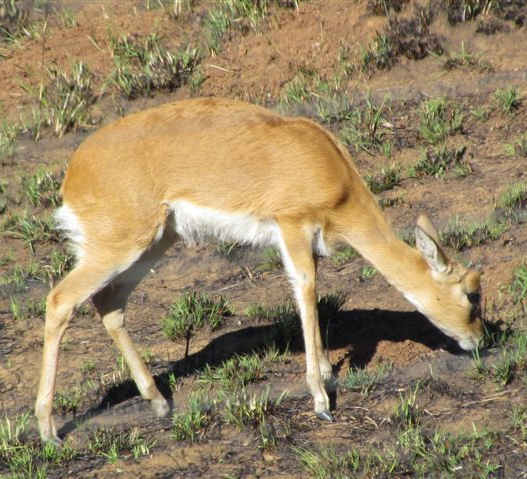Jiba Magwaza of the Endangered Wildlife Trust discusses the results of the most recent Oribi census which many farmers and landowners participate in annually. Please contact the EWT should you have any oribi on your land and consider participating in their annual survey.
The Oribi census is an exercise used to monitor animal numbers in private and protected areas. The period September to November is chosen because this is when the grasslands that have been burnt are flushing green making the Oribi easier to see as they are attracted to this green flush. Unfortunately in 2014 this was rather difficult with delayed rain leaving landowners skeptical of burning, thus making it difficult to count animals since they hide in the standing tall grass.
Oribi (Ourebia ourebi) surveys have been conducted in South Africa for over fifteen years and for that the Oribi Working Group would like to thank each and every landowner who has been involved since day one of this long-term survey effort. The Oribi Working Group saw a need to monitor Oribi because of the rate at which the population was perceived to be decreasing. Oribi face a lot of threats and require ongoing conservation attention in South Africa, as a working group we are committed to working with private landowners and protected land managers to ensure the conservation of this beautiful species.
In 2014 a total of 3006 Oribi were counted in South Africa from 266 survey returns, these numbers include protected areas and privately owned properties. When comparing between provinces KwaZulu-Natal submitted more surveys and has the highest number of animals, 1583 from 149 returns. KwaZulu-Natal is followed by the Eastern Cape with 1103 animals from 88 returns and then Mpumalanga which submitted 29 surveys and had a total of 320 animals.

Total national survey results and number of records as compared to previous year’s results. EKZNW reserve counts were included in 2003, 2005, 2011, 2012, 2013 and 2014. 1998-2003 only included KZN province, thereafter the survey had a national focus. All of these values have been revised based on the discovery of historical data records previously not included.
Oribi surveys data to date have shown a high level of fluctuation of animal numbers with an increase in recent years of years back to similar numbers as recorded at the change of the century. This fluctuation in numbers is a result of varying survey efforts resulting from changes in the survey team and shifting levels of capacity. The crux of the story is that overall numbers in the country sit at just over 3000 animals and regionally populations have declined dramatically. The KZN population has about halved since 2001.Of concern is the high number of properties who are not sure of their population trends coupled with a high reporting rate of decreasing numbers. Mpumalanga submitted only 29 returns and the Oribi Working Group would like to see more returns from this Province in order to assess the overall trend.
Unfortunately Oribi are faced with many threats. These animals are an easy target for predators and humans. As grassland specialists they need good quality grasslands to survive, if it is disturbed in any way Oribi will have a hard time surviving. The 2014 Oribi survey reported that poaching with dogs is by far the most prominent threat, followed by stray dogs then snaring and illegal shooting. Another major threat to Oribi is habitat destruction, with considerable development (including widespread mining and agriculture) taking place in grassland areas. From our experience these threats are not confined to any province in particular and are significant throughout the region.
The issue of poaching with dogs is a serious threat and has seen a significant recent increase with the shift from hunting as a hobby to poaching and gambling in large numbers (also called taxi hunting). The EWT, EKZNW, The KZN Hunters and Conservation Association and SACAN are working closely with each other to tackle all these issues by working directly with landowners and communities at large. Environmental education and awareness is very important for all of us to achieve our conservation goals. Collectively we can do more and make a difference by tackling all the problems faced not only by Oribi but all of our natural resources.
For more information or to report poaching with dogs contact SACAN on 08-616-72226.





We love this dainty little antelope and consider every encounter a special treat. Sad to read that it seems their population continues to decline.
LikeLike